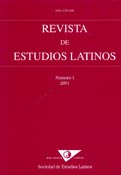El gramático y la princesa o la historia de Esmirna y Crasicio
DOI:
https://doi.org/10.23808/rel.v7i0.87877Palabras clave:
Metalepsis; paternidad intelectual; incesto literario.Resumen
El artículo estudia un epigrama del De Grammaticis et Rhetoribus de Suetonio dedicado al gramático Crasicio. Esmirna, la princesa que da nombre al poema de Cinna, Zmyrna, rechaza a todos sus pretendientes y elige como marido al gramático Crasicio, porque, debido a su profunda erudición, conoce todos los secretos de la novia (y de la obra). La figura retórica mediante la cual un personaje de ficción salta desde su nivel narrativo al del autor ha sido llamada metalepsis por Genette. También estudiamos algunos temas estrechamente relacionados con esta figura retórica como el de la paternidad literaria y el incesto artístico (Pigmalión). Parece que a los autores literarios les disgusta que los libros, sus hijos intelectuales, alcancen la libertad al ser libremente interpretados por sus lectores.
El gramático Crasicio también era un autor de mimos (mimographus). La punta del epigrama aún podría ser más incisiva si el escritor de mimos y la primera actriz estuvieran casados en la realidad, tal como estaban en la ficción del epigrama.
Descargas
Descargas
Publicado
Cómo citar
Número
Sección
Licencia
Derechos de autor 2007 Revista de Estudios Latinos

Esta obra está bajo una licencia internacional Creative Commons Atribución-NoComercial-SinDerivadas 4.0.
Los originales publicados en las ediciones impresa y electrónica de esta revista son propiedad de las personas autoras de los mismos y se podrán difundir y transmitir siempre que se identifique la fuente original y la autoría en cualquier reproducción total o parcial de los mismos, y siempre que no tengan una finalidad comercial.






